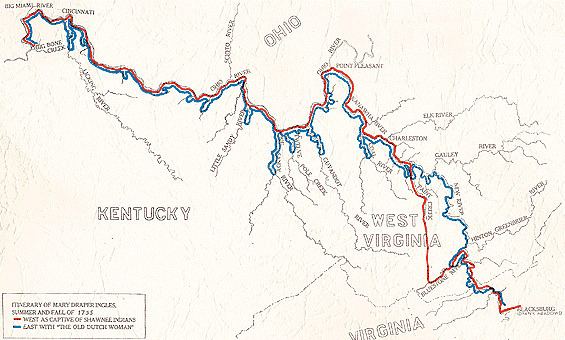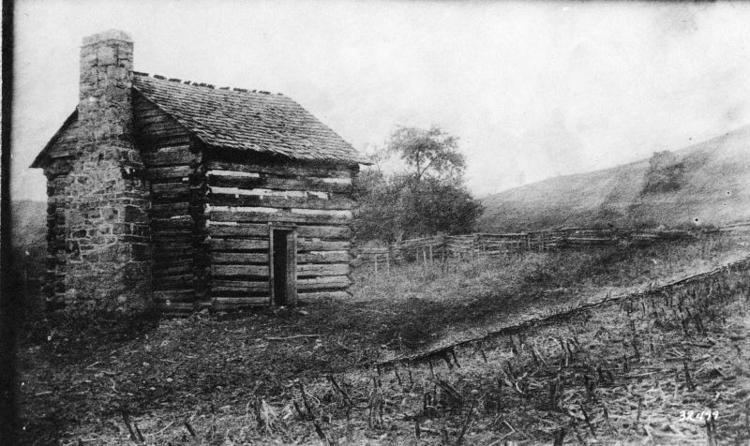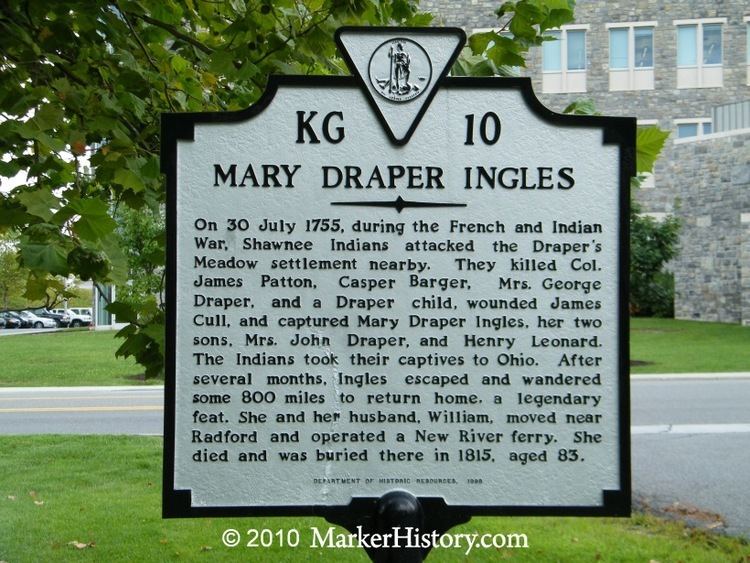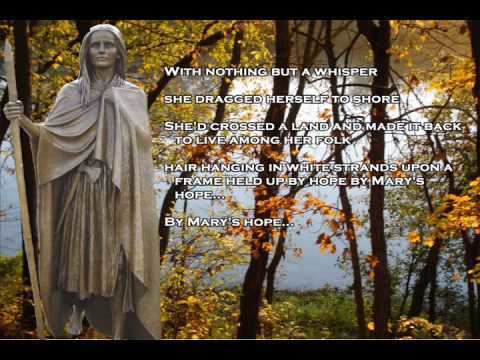Name Mary Ingles | ||
 | ||
Died February 1815, Ingles Ferry | ||
Mary draper ingles kanawha new rivers trail wmv
Mary Draper Ingles (1732 – February 1815), also known in records as Mary Inglis or Mary English, was an American pioneer and early settler of western Virginia. In the summer of 1755 she and her two young sons were among several captives taken by Shawnee after the Draper's Meadow Massacre during the French and Indian War. They were taken to Lower Shawneetown at the Ohio and Scioto rivers. Ingles escaped with another woman after two and a half months, making a trek of 500 to 600 miles, crossing numerous rivers and creeks, and over the Appalachian Mountains to return home.
Contents
- Mary draper ingles kanawha new rivers trail wmv
- Mary draper ingles escape from indian captivity
- Early life
- Drapers Meadow massacre
- Captivity
- Escape and journey home
- Aftermath
- Historical accounts of Mary Draper Ingles journey
- In popular culture
- Memorialization
- References

Mary draper ingles escape from indian captivity
Early life

Mary Draper Ingles was born in 1732 in Philadelphia, Pennsylvania to George and Elenor (Hardin) Draper, who had immigrated to America from Donegal, Ireland in 1729. In 1748, the Draper family and others moved to the western frontier of Virginia, establishing Draper's Meadow, a pioneer settlement on the banks of Stroubles Creek near modern-day Blacksburg.

In 1750 Mary married fellow settler William Ingles (1729-1782). They had two sons together: Thomas, born in 1751, and George in 1753.
Draper's Meadow massacre

On July 30 (or July 8, according to one source), 1755, during the French and Indian War, a band of Shawnee warriors (then allies of the French) raided Draper's Meadow, killing four settlers, including Mary's mother and her infant niece. They took six captives, including Mary and her two sons, her sister-in-law Bettie Robertson Draper, and neighbors James Cull and Henry Lenard (or Leonard). Mary's husband was nearly killed but fled into the forest.
Captivity

The Indians and their captives traveled for a month to Lower Shawneetown, located at the confluence of the Scioto and Ohio rivers. The Shawnee killed James Cull and Henry Leonard during the ritual of running the gauntlet. Mary was separated from her sons, who were adopted by Shawnee families.

Some sources suggest that Mary gave birth to a daughter while in captivity although there is evidence to the contrary. As a prisoner, Mary sewed shirts using cloth traded to the Indians by French traders, and was paid in goods for her work. In October 1755 she was taken to the Big Bone salt lick to make salt for the Indians by boiling brine.
Escape and journey home
While working at Big Bone Lick, in late October 1755, Mary persuaded another captive woman, referred to as the "old Dutch woman" but who may have been German, to escape with her. The next day (probably 19 October) they set off, retracing the route that the Indians had followed after Mary was taken captive in July. They wore moccasins and carried only a tomahawk and a knife (both of which were eventually lost), and two blankets. As they were leaving the camp, they met three French traders from Detroit who were harvesting walnuts. Mary traded her old dull tomahawk for a new one.
They went north, following the Ohio River as it curves to the east (see map). Expecting pursuit, they tried to hurry at first. As it turned out, the Shawnee made only a brief search, assuming that the two women had been carried off by wild animals. The Shawnee told this account to Mary's son Thomas Ingles when he met some of them many years later after the Battle of Point Pleasant (1774).
After four or five days the women reached the junction of the Ohio with the Licking River, near the present-day location of Cincinnati. There they found an abandoned cabin, which contained a supply of corn, and an old horse in the back yard. They took the horse to carry the corn, but he was lost in the river when they tried to take him across what was probably Dutchman's Ripple.
They followed the Ohio, Kanawha, and New rivers, crossing the Licking, Big Sandy, Little Sandy rivers, Twelvepole Creek, the Guyandotte and Coal rivers, Paint Creek, and the Bluestone River. During their journey, they crossed at least 145 creeks and rivers—remarkable as neither woman could swim. On at least one occasion they "tied logs together with a grape-vine [and] made a raft" to cross a major river. They may have traveled as much as five to six hundred miles, averaging between eleven and twenty-one miles a day.
Once the corn ran out, they subsisted on black walnuts, wild grapes, pawpaws, Sassafras leaves, blackberries and frogs but, as the weather grew cold, they were forced to eat dead animals that they found along the way. On several occasions they saw Indians hunting, and each time managed to avoid being seen.
At some point during the journey, the old Dutch woman became "very disheartened and discouraged" and tried to kill Mary. (Letitia Preston Floyd's account states that the two women drew lots to decide "which of them was to be eaten by the other.") Mary managed to "keep her in a good humor", and soon afterward they reached the mouth of the Kanawha River. But, shortly after they reached the New River, the old Dutch woman made a second attempt on Mary's life, probably on 26 November.
By now the temperature had dropped, it was starting to snow, and the two women were weak from starvation. Mary feared that the old Dutch woman would kill her in her sleep, so one night she went off alone and, finding a canoe, crossed the New River at its junction with the East River near what is now Glen Lyn, Virginia. Mary continued southeast along the riverbank, passing through the present-day location of Pembroke. She reached the home of her friend Adam Harmon on or about 1 December 1755, forty-two days after leaving Big Bone salt lick. A search party went back and found the old Dutch woman shortly afterward. Adam Harmon took her to the fort at Dunkard Creek, where she joined a wagon party traveling to Pennsylvania.
Aftermath
After recovering from her journey and reuniting with her husband, Mary had four more children: Mary, Susan, Rhoda (b.1762), and John (1766-1836). In 1762 William and Mary established the Ingles Ferry across the New River, and the associated Ingles Ferry Hill Tavern and blacksmith shop. She died there in 1815 at the age of 83. The site of her former log cabin, with a stable and a family cemetery, is protected as part of the Ingles Bottom Archeological Sites.
Mary's son George died in Indian captivity, but Thomas, who was four when taken captive, was ransomed and returned to Virginia in 1768 at the age of seventeen; after 13 years with the Shawnee, he had become fully acculturated and spoke only Shawnee. He underwent several years of "rehabilitation" and education under Dr. Thomas Walker at Castle Hill, Virginia.
Thomas Ingles later served as a lieutenant under Colonel William Christian in Lord Dunmore's War (1773-1774) against the Shawnee. He married Eleanore Grills in 1775 and settled in Burke's Garden, Virginia. In 1782 his wife and three children were kidnapped by Indians. Thomas came to rescue them and in the ensuing altercation, the two older children were killed. Eleanore was tomahawked but survived. She and her youngest daughter were rescued by Thomas.
In 1761 Mary Ingles' brother John Draper attended a gathering of Cherokee chiefs at which a treaty to end the Anglo-Cherokee War was prepared. He found a man who knew of his wife, Bettie Robertson Draper, who had been taken captive in 1755. At that time, she was living with the family of a widowed Cherokee chief. She was ransomed and John took her to New River Valley.
Historical accounts of Mary Draper Ingles' journey
The two primary sources of information are:
1) the 1824 written account by John Ingles (son of Mary and William Ingles, born after Mary's return);2) parts of an 1843 letter by Letitia Preston Floyd (wife of Virginia Governor John Floyd and daughter of Colonel William Preston, a survivor of the Draper's Meadow massacre).Differences between the two narratives suggest that the Ingles and Preston families had developed distinct oral traditions. They differ on the date of the massacre (July 30 vs July 8, according to Ingles and Floyd, respectively), the number of casualties, the ages of Mary Ingles' children, and several other aspects.
John Peter Hale, one of Mary Ingles' great-grandsons, claimed to have interviewed Letitia Floyd and others who knew Mary Ingles personally. His 1886 narrative contains numerous details not cited in any previous account. There were some references to Mary Ingles' escape in contemporary reports and letters, which were gathered in later efforts to document people who had been taken captive by Indians.
In popular culture
The story of Ingles' ordeal has inspired a number of books and films; these include the following:
From 1971 to 1999, an outdoor historical drama, called The Long Way Home, was produced each summer at the Ingles homestead, relating the history of Mary Draper Ingles and her family. It was identified as the "official" outdoor drama by the General Assembly. While it attracted thousands to the city, the production was finally closed. Since 2010, other efforts have been made to develop aspects of tourism heritage related to the Ingles history.
